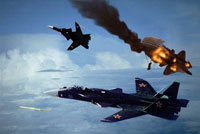Why Does Russia Buy Military Hardware from Other Countries?
News reports about Russia’s intentions to purchase arms from abroad have become frequent recently. Russia purchased unmanned aircraft from Israel, a destroyer from France, small arms and aviation equipment from other countries, etc. What is happening in the Russian defense industry? Why does Russia have to purchase military hardware from abroad if it takes one of the leading positions on the international market of arms exports?

Ruslan Pukhov, the director of the Center for the Analysis of Strategies and Technologies, believes that the import of arms is an ancient tradition in the history of the human civilization.
“Arms imports have centuries of history. The Russian history of the imports of arms started practically simultaneously with the appearance of the Russian State. Ivan III the Great, who established centralized Russia, was purchasing small arms from Europe, especially from Denmark. Sweden was Russia’s major source for arms, especially cannons, during the second half of the 17th century. Russia continued importing arms on the threshold of the war with Japan. Russia’s best vessels of the Pacific Navy were built in France, the USA and Denmark. During World War I Russia was purchasing practically all types of arms from other countries because the domestic industry was unable to produce them in required quantities.
“Things changed after the establishment of the Soviet Union. The USSR was a large economy and could afford self-sufficiency in the defense industry. The USSR was in an opposition to the Western world and could not tolerate any sort of dependence on the West. However, the Soviet administration had to purchase hardware and spare parts from foreign states anyway, even from capitalist countries.
“In the beginning of the 1960s, the Soviet Union decided to launch the production of training aircraft for the countries of the Warsaw Pact in Czechoslovakia. The USSR was purchasing large amphibious warfare ships from Poland. In the beginning of the 1980s, the Soviet Union had to purchase large Bridgestone tyres from Japan. The tyres, 3 meters in diameter, were bought for a missile complex because the Soviet industry could not produce the tyres of such a large diameter.
“As for the USA, this country spends billions of dollars on purchasing arms from other countries. The USA mostly cooperates with its NATO allies at this point, Britain first and foremost. It purchased direction-lift Harrier planes from Britain and cooperated with this country in the development of the fifth-generation F-35 fighter jet.
“There is no country in the world that exports best products of its defense industry. This is a general rule on the arms market. Russia made an exception from this rule in the beginning of the 1990s when it started to export Su-30MKI and MiG-29CMT fighter jets.
“The USA tries to show influence on the countries that sell their arms to Russia. The Americans have done that with Israel – they do not want their staunch ally to sell its best unmanned aircraft to Russia. It is obvious that the United States does not want Russia to gain access to state-of-the-art military technologies. When France criticized the US-led incursion in Iraq in 2003, the United States said that it would suspend the shipments of spare parts and equipment for France’s Hercules planes. In return, France said that it would inform potential customers of US arms about such activities of the United States. The latter was eventually forced to back down.
“I believe that Russia will continue to purchase arms from abroad in the future. This is a contradictory process. On the one hand, people may lose their jobs, and the home production may decrease. On the other hand, such activities give Russia an opportunity to develop the power of the nation’s armed forces and increase the competitive ability of the defense industry.
Komsomolskaya Pravda
Russia Today: Moscow panics following discovery of WWII weapons cache
Subscribe to Pravda.Ru Telegram channel, Facebook, RSS!




